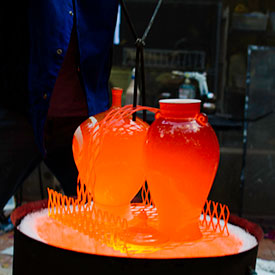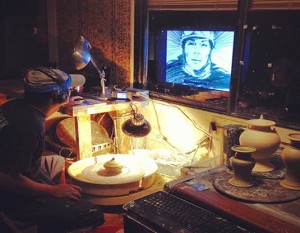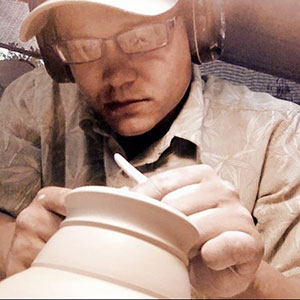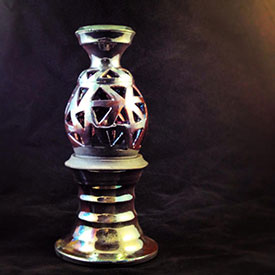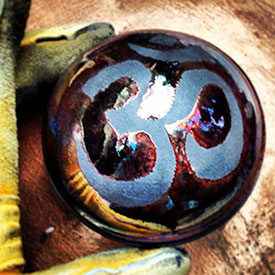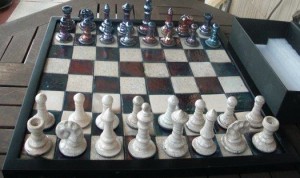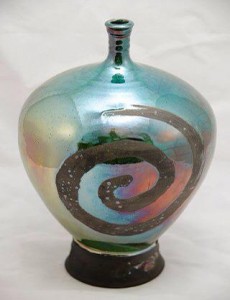I was surprised when I googled the entry “passionate/enthusiastic Potter” and my results did not bear the name Larak Briscoe, because you will never meet a more fervent potter in our day.
I was fortunate to interview this master craftsmen and discus his artistry and how he channels the ancestral wisdom for his life long vocation.
Could you tell me about your craft what it’s called and a description on what it is?
I started doing pottery almost 20 years ago, when I was a sophomore in High School. What I do now is almost exclusively wheel thrown ceramics, fired in Raku. For sake of simplicity you could say I am a Raku Potter.
Raku, if you’ve never heard of it, is an ancient ceramic firing technique developed in the 16th Century in Japan by tea masters where the pots are fired very quickly up to an eyeball-guestimate of 1800 degrees F, then using some long heavy duty tongs, taken out of the kiln while still glowing red hot. There are many derivatives of what happens next, and timing is key. Depending on what glaze is used, some pots are thrown directly to cool in water (as with traditional Raku), some “luster” glazes are thrown in a combustion chamber with heaps of newspaper or sawdust, then “flashed” with oxygen to bring about colorful almost metallic affects. Others are left “naked” where the clay body itself is exposed after scraping off a thin layer of slip, revealing intricate partly purposeful designs in stark white and black.
What motivates you to continue your craft and what enjoyment do you receive?
I get enjoyment out of all of it; the ups and the downs. By nature, Raku has a very high breakage ratio, for instance. And consistent results are almost impossible to achieve.Though these aspects might not be very motivating, as an artists on this lifelong journey, it makes me appreciate the challenge of my craft, and celebrate that much more, in the times I am successful.
I am motivated most of all, by just knowing I am creating something beautiful that is one of a kind. Something that I put heart and soul into and created start to finish… and if I’m fortunate enough that another person appreciates it, buys it, even cherishes it, then that’s a bonus.
Where did the name Raki Raku Pottery originate?
The Raki Raku Pottery name, well it just worked out that way. My given name is Larak , but I go by Raki. At some point after stumbling onto Raku, I decided to register my company as Raki Raku Pottery.
Could you explain the Raku Philosophy of Imperfection and how that could apply outside of pottery?
Back in the day, starting around 400 years ago, when the tea ceremony vessels were made in Raku, the desired aesthetic was established to be “imperfect,” or asymmetrical. I’ve read over and over how these lopsided pots are masterfully crafted, but to be honest, part of me will never get it. For me the craft reaches beyond just the pot. It’s the entire endeavor of being an artist. I like my pots iconic, shiny, and completely symmetrical. They are to celebrate life and the elements that bring us through it.
The philosophy of Imperfection, however, I fully embrace. The basic idea as I understand it is: art is created to make you contemplate life. In a piece of pottery, you might see an impression, and then recognize it as the Potter’s hand leaving its mark on the clay. Outside of pottery, I suppose life itself is full of awkward impressions, dings, scrapes, and general unevenness. One must be able to accept how things are and enjoy being in itself. Nothing is perfect.
Is there a large difference between traditional and western Raku?
Traditional Raku was created for a ceremonious drinking of tea. The Raku was intently simple, made for holding comfortably and perhaps not to draw attention to the vessels, so one could focus. Browns and blacks, earthy tones were used. Remember, we’re talking about ancient Japan, so that means living their austere life with a sense of duty, discipline, harmony, and above all, enlightenment.
Western Raku, is not confined by rules of austerity and functionality imposed on aesthetics by the traditional Raku tea ceremony.
There are a couple individuals that are accredited with completely reinventing Raku. Bernard Leach, from England, and Paul Soldner from the U.S.
They experimented with the craft and developed a completely new addition to the firing process and the post firing reduction. The entire flashing process was literally invented by these guys! Basically, instead of taking the glowing red hot pots out of the kiln and cooling them by air and water, the pottery was instead quickly thrust into a combustion chamber, and then allowed to oxidize (flash). It is this process alone that causes the metallic luster’s that Raku is often known for.
To me, these guys are the Bill Gates and Steve Jobs of Pottery. Their work, and their willingness to share their methodology, resulted in what I associate to be Western Raku, or American Raku.
Where do you see Raku in 5 years 10+ years?
I would like to see more educational programs on the high school and university level carry raku pottery programs. Also, I would like to see the technique well documented in high production value multi-media on the web with potters active in a community sharing their discoveries.
I would, of course, love to see the craft go through another epic transformation, such as what Soldner and Leach have done. I don’t know that would be… perhaps some movement that included a blockbuster movie, a sold out benefit concert, or a mega dj. I don’t know. The sky is the limit for my expectations of this artform.
If I had my dithers. I’m holding out for Raku Pots transmuting into Hogwarts port keys!
Are there any Potters that have influence your through the years or mentors to name?
Somewhere along the line back in high school ceramics class, Senior year, I read a book about a famous potter named Thomas Coleman. The author was a good friend of my father’s and he has since passed. He wrote it from a journalist’s perspective, capturing the endeavor of a talented unknown on the brink of stardom. The book is titled, “The Mudpie Dilemma”. And it delves into the core nature of artists, “Should one make what sells, or make what satisfies his/her own muse of creativity”. At the time the book was written (1977, the year I was born), Coleman was a no-name. Since reading that book I have always followed Coleman’s career, which took off thereafter.
I have learned a lot throughout the years from artists that i have shared studios with or gotten to see work in person. Locally I work from time to time with some artists that continually help reset my bearings and decide what direction to go with my art. When I’m not working in my studio at home, I share a studio with a wildly talented group of potters on the west side at Leeward Community College. The instructor there, Russell Wee, is a phenomenal Raku artist. His pieces go for thousands of dollars and yet he is one of the most humble persons I know. Another close friend and mentor that I consider to be a master, is Ramon Camarillo. His throwing abilities are unparalleled. He can make a 2 foot vase the size of a Samoan toddler with just 8 pounds of clay. It’s amazing to watch him work. What I love about the dynamic I share with the great potters I know, is we all make exceedingly different pieces. Though I admire their work very much, I wouldn’t dare try to recreate what they are working on, and it goes without saying, I don’t see anyone else trying to do what I do. That is the nature of the craft. Potters are a rare breed. Even still, no two potters do anything exactly the same. The end results always end up completely different.
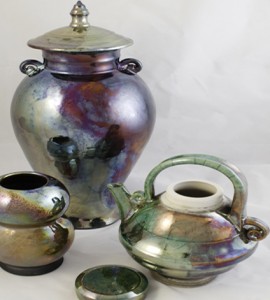
How is the Hawaii Pottery Scene?
It’s great. There are so many talented potters here.
Once a year we all rally together for a Raku festival in the North Shore. There are typically 50-100 Raku artists that participate in a three-day camp out that doubles up as a juried show. By the end of the three days all the artists lay their works from the weekend out on the beach. A guest artist then plays juror and selects his or her favorites out of the collection. That collection goes on display in Mark’s Garage Art Gallery in Chinatown for the summer months. Friends and family attend and we even get some foot traffic. It’s an awesome event that most of us Raku Potters look forward to each year.
Here in Hawaii, I don’t know any professional artists that make a living solely on the art they create. Certainly not potters! You have to teach, or open up shop, or by some factor, sell out to an industry. I think it has to do with Hawaii’s economy being largely funded by tourism, and in general, not having enough affluence and population. How many retail items do you see with a turtle or dolphin emblazoned on it, and people go gaga over it. To me that’s a desecration of the soul. And yet, my daily puzzle is how to compete with that! I don’t know how many times I’ve shared pictures of my pottery to people and they say excitedly, “you should go swap meet”!
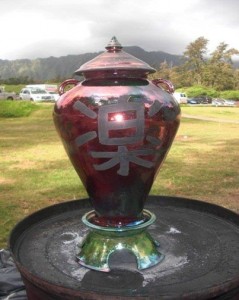
Any advice to anyone who would like to do some research on Raku and or learn Raku Pottery?
Best resources = Google, YouTube, Wikipedia, Amazon, Public Library or local listings for Raku pottery classes.
As mentioned earlier, I highly recommend “The Mud-Pie Dilemma” by John Nance
I am also available as a resource. I have been known to demo re-firings on at least a few occasions!
Where can you be contacted for further questions or commissioned work?
Send me an email at rakiraku@gmail.com or contact me on Facebook. I love doing commissioned orders and have a lifetime re-firing policy if you are local to Hawaii.


